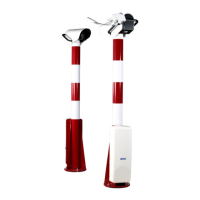User's Guide ______________________________________________________________________
40 __________________________________________________________________ M210667EN-C
- As an operational parameter which corresponds to specific criteria for
special applications.
In this case, the concept of visibility is applied directly in terms of the
distance of visibility.
To simplify this problem and to enable quantitative physical
measurement, the factors involved in estimating visibility distance can be
separated as follows:
- Photometric and dimensional characteristics of the object which are,
or should be, perceived.
- Conditions of visual perception, including the effects of extraneous
lightning and observer location.
- Optical state of the atmosphere between the object and the observer.
The photometric and dimensional characteristics of visibility objects are
readily defined and measured in specific instances. The conditions of
visual perception have been investigated, and statistical quantitative
evidence of these factors is available.
The above factors include the visual threshold of illuminance (εt) and the
threshold value of the luminance contrast.
The optical state of the atmosphere depends directly on meteorological
conditions, its basic parameter being the visual extinction coefficient
Of the factors described above, only the optical state of the atmosphere
directly depends on the meteorological conditions. It is, therefore,
important that this basic visibility parameter express the optical state of
the atmosphere objectively, and not be influenced by extra-
meteorological conditions.
This objectively-expressed visibility parameter forms a basis for the
concept of visibility.
Meteorological Optical Range
The meteorological optical range (MOR) is a conveniently derived
parameter. MOR assumes that in practical circumstances the eye can only
recognize patterns at a luminance contrast threshold of 5 per cent. From
MOR, one can infer specialized visibility parameters. Conversely, MOR
can be estimated from particular visibility observations.
Since the World Meteorological Organization (WMO) has defined
"visual range" in units of the distance within which a black object can be
detected and recognized on the horizon in daylight, visual range as
defined by WMO is calculated using a term developed by Koschmieder
for the visual range of a black object against the horizon-level sky.

